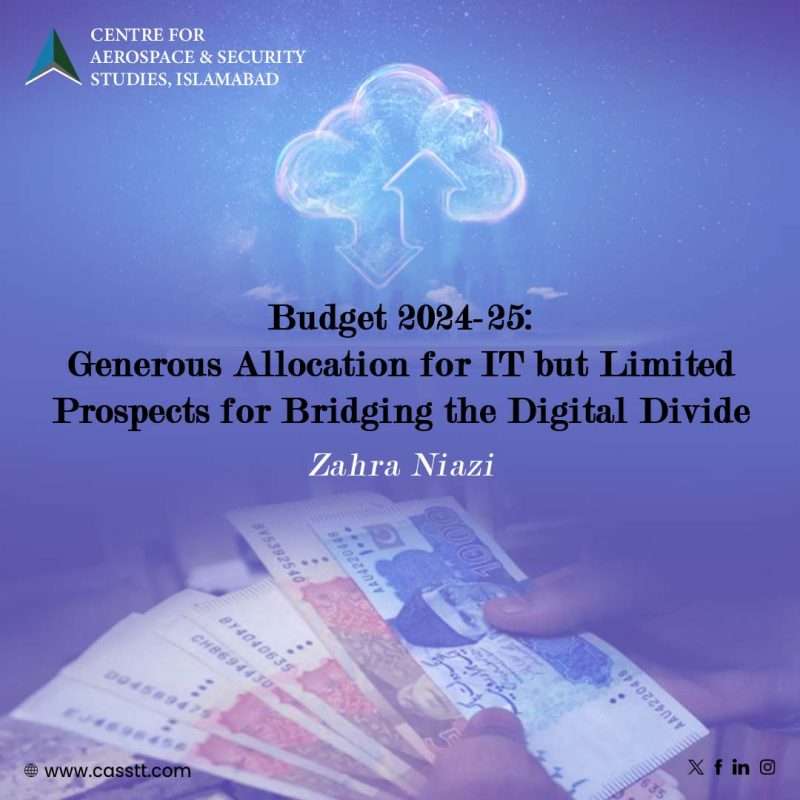On 12th June, Pakistan’s coalition government unveiled the proposed budget for the fiscal year starting 1st July with a total outlay of PKR 18.9 trillion, representing an almost 25% jump from the outgoing year’s revised expenditure estimates. As always, the upcoming fiscal year’s budget had different meanings for different stakeholders.
For the Information Technology (IT) sector, it had some positive features. In his budget speech, the Finance Minister prominently highlighted the budgetary allocation for the IT sector while acknowledging the sector’s potential to yield huge returns in a relatively shorter period through targeted investments.
The allocation of more than PKR 79 billion for the IT sector is impressive. This time, the Information Technology and Telecommunication (ITT) Division has been allocated PKR 28.9 billion from the Federal Public Sector Development Program (PSDP) funding, compared to just PKR 6 billion in the outgoing fiscal year, representing a massive increase of nearly 382%.
Under the section of grants, the allocation of at least PKR 32.3 billion for four explicit categories related to IT, including for digital information infrastructure initiatives; Pakistan Software Export Board (PSEB) for IT exports; digitalisation of the Federal Board of Revenue (FBR)/ IT upgradation and restructuring; and other information technology initiatives, is a pragmatic move. In contrast, IT-specific categories received a PKR 2 billion share in the outgoing fiscal year’s budget. These figures exclude the grants that may be allocated for the sector from the ‘miscellaneous’ category or are apportioned for other initiatives that can positively influence the IT sector.
While this presents an encouraging outlook, a deeper overview suggests that the proposed budgetary measures and allocations may do little to bridge the daunting challenge of the digital divide and, in some ways, even exacerbate it. This not just limits the realisation of our IT sector’s full potential but also risks furthering an inequitable digital future.
Consider, for instance, the distributional aspect of the total budgetary allocation for the IT sector. While the budget document does not provide a detailed breakdown of the allocated amount, there is some information on the specifics in the budget speech delivered by the Finance Minister. What it suggests is that four projects/areas will receive significant chunks of the allocated amount for the IT sector: PKR 20 billion for the digital information infrastructure initiatives; PKR 11 billion for the technology park development project in Islamabad; PKR 8 billion for the IT park project in Karachi; and PKR 7 billion for the digitalisation and reforms of the FBR. Another PKR 2 billion has been earmarked for the PSEB to facilitate exporters and students in acquiring internships in IT firms, and PKR 1 billion has been reserved for establishing a National Digital Commission and a Digital Pakistan Authority.
A further breakdown of the allocated amount still needs to be unveiled. However, specific reference to these projects in the budget speech suggests they may remain the government’s top priorities for the IT sector. Digitalisation of the tax revenue collection mechanism is indeed a need of the time, and so were the digital information infrastructure initiatives to safeguard essential information assets in the face of evolving cyber threats. Similarly, the technology park projects can play a vital role in facilitating collaboration, boosting jobs for IT professionals, and attracting investment in the sector.
However, in a country with considerable differences in ICT usage capabilities across various categories and over 50% of the population lacking access to the internet due to inadequate digital infrastructure and affordability issues, initiatives aiming to bridge the digital divide warranted at least equal, even if not more, attention. While a measure has been proposed in the budget document to provide schools with tablets, smart screens, Chromebooks, and internet access, given the lack of adequate telecom infrastructure and ICT usage capabilities among teachers in underprivileged areas, the question is whether this will improve or worsen digital literacy gaps.
Another example comes from the taxation part. The government has proposed doubling the sales tax on laptops and computers from 5% to 10%. What’s more, an 18% sales tax has been proposed on mobile phones. In a country where digital development is already 15-fold (or 15x) higher in the richest quintile compared to the poorest, the taxation measures on these basic technologies can potentially exacerbate this divide.
Pakistan’s IT sector is advancing, yet the full realisation of its vast potential hinges on our ability to bridge the digital divide. To harness this potential, programmes targeting this divide must not only be included but seriously followed up in the budgetary frameworks for IT. Additionally, any taxation on digital technologies demands a nuanced approach – each measure must be meticulously weighed, assessing the potential benefits against the potential costs.
They say, ‘A stitch in time saves nine.’ While a single year’s budget cannot transform the digital landscape of our country, procrastination will only exacerbate issues, making them more complex and resource-intensive to resolve later. There is no running away from the technological revolution sweeping the planet. We need to act today to ensure an inclusive and strong digital tomorrow.
Zahra Niazi is a Research Assistant at the Centre for Aerospace & Security Studies (CASS), Islamabad, Pakistan. The article was subsequently published in The News International. She can be reached at [email protected].





